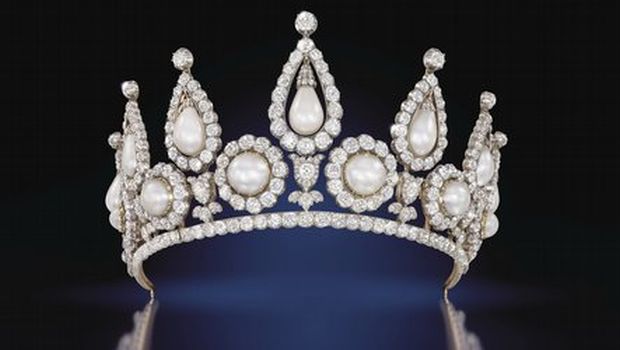
Lady Rosebery’s pearl and diamond tiaraLondon c.1878The Qatar Museums Authority Collection(Photo © Christie’s Images)
London, Asharq Al-Awsat—Upon entering the mysterious, charming, and dimly lit hall that hosts the Pearl Exhibition in the Victoria and Albert Museum in London, one is immediately overwhelmed with a feeling of diving into the deep sea.
On display at the exhibition are over 200 pieces of jewelry and works of art that celebrate the aesthetic value of the pearl and its function as symbol of status and wealth. It begins with an insight into the natural history of pearls and explores the trade route from the Arabian Gulf to Europe and Asia, and then moves on to celebrate a wide range of unique pieces made from pearls from all over the world.
The exhibition is based on a similar display that took place in Doha, Qatar, in 2012, which highlighted the importance pearls and the pearl-diving industry throughout the history of the Arabian Gulf, as well as the impact of the pearl on the jewelry industry worldwide.
In collaboration with the Qatar Museums Authority, the exhibition was transferred to London and entrusted to jewelry experts Beatrice Chador Simpson and Huber Barry, the latter of whom is the head of Qatar’s jewelry museum, which is currently in the planning stage.
In a conversation with Asharq Al-Awsat, Simpson her biggest challenge in bringing the exhibition to London was adapting it to suit the British public. She said: “As an expert on the history of jewelry, I was entrusted to reformulate the exhibition to fit the Victoria and Albert Museum. We have already expanded and added to the previous exhibition and include some new themes. The work took about a year, including the completion of a very special book.”

A rare selection of natural pearls from the Qatar Museums Authority CollectionThe Qatar Museums Authority Collection(Photo © Creutz)
She said the main difference from the exhibition in Doha was the inclusion of a broader range of pearls: “There is the historical aspect, alongside the story of pearl diving and the industry in the Gulf. We chose to show the history of pearl use from the Roman times through the medieval era and up to the 19th century. I think we have presented the Arabian Gulf pearls in a global and historical context.”
Simpson adds that the historical narrative also addresses the role of the Japanese Mikimoto in pearl production after discovering pearl farming.
The exhibition includes a pearl-drop earring worn by Charles I to his execution in 1649, as well as a necklace of cultured pearls given to Marilyn Monroe, pieces worn by Marie Antoinette, and beautiful pearl tiaras worn by the European aristocracy throughout history.
From the other side of the world, also on display are an Indian Maharajah’s coat embroidered with pearls, a Chinese imperial robe studded with pearls, as well as wedding head-dresses, also from China.
After an extensive display of historical pieces, the exhibition moves on to present artificial pearls and the industrialization of pearl production initiated by Kokichi Mikimoto in Japan. This includes a set of pots bearing piles of Chinese pearls, in reference to the fact that the pearl, enjoyed by an exclusive minority in the past, has become accessible to everyone. “It displays the democratization of the pearl,” as Simpson described it.
Local and contemporary pieces include the crown worn by the late Princess Diana and earrings that belonged to actress Elizabeth Taylor. There is also a pearl-studded necklace made by Cartier, on which Simpson remarked: “When we see this simple piece, we don’t know the time and effort invested in it. Cartier traveled to the Arabian Gulf specifically to pick the pearls himself. It is not easy to select optimum pearls and they don’t come in similar sizes and with similar sparkle. If we consider the history of the pearl, the number of divers who sank into the depths of the ocean for pearls, and the number of shells opened to find the perfect pearl beads, we see that the process is very detailed.”
[divider]
“Pearls” runs at the Victoria and Albert Museum in London until January 19, 2014. More information can be found on their website.
